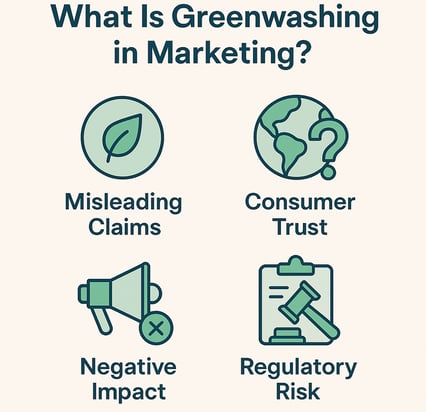The Truth About Greenwashing
Why Authentic Sustainability Marketing Matters More Than Ever
5/26/20253 min read


Today’s consumers—especially Millennials and Gen Z—are shopping with their values. As climate concerns grow, people are voting with their wallets, prioritizing brands that seem to care about the planet. According to NielsenIQ, nearly three-quarters of global consumers say they would definitely or probably change their consumption habits to reduce environmental impact.
In response, brands are ramping up their eco-friendly language and visuals. But here's the catch: not all of it is honest. Some companies are exaggerating—or outright fabricating—their sustainability claims. This deceptive marketing practice is known as greenwashing.
Let’s dive into what greenwashing is, why it’s harmful, real-world examples, and how marketers can communicate responsibly while still promoting their environmental values.
What Is Greenwashing?
Greenwashing refers to marketing that gives a false impression of environmental responsibility. It’s when a company claims to be more sustainable than it actually is—whether through vague language, misleading visuals, or selective reporting. This can involve exaggerating green efforts, promoting insignificant eco-friendly details, or hiding unsustainable practices.
Greenwashing can be intentional or a result of poor communication. Either way, it risks eroding public trust and bringing serious legal or reputational consequences.
Why Is Greenwashing a Problem?
While greenwashing may seem like a shortcut to attracting eco-conscious customers, it often backfires. Here's why:
Brand damage: Getting called out for greenwashing can lead to a PR crisis.
Consumer trust loss: Transparency is key. Once trust is lost, it’s hard to earn back.
Legal risk: Regulatory bodies are cracking down on misleading environmental claims.
Social backlash: Consumers are vocal—especially on social media. A single misleading ad can spiral into viral criticism.
Internal impact: Employees who care about sustainability may feel conflicted or disillusioned.
Investor hesitancy: Misalignment between words and actions can scare away stakeholders.
Missed opportunity: Companies that are doing the right things may hesitate to speak out—what’s now being called greenhushing—out of fear of scrutiny.
Examples of Greenwashing
Here are four distinct cases of brands that faced criticism for greenwashing:
1. Ryanair: “Europe’s Lowest Emissions” Claim
The budget airline ran ads claiming it was Europe’s lowest emissions airline—without sufficient evidence to back up the claim. The ads were banned in the UK after being ruled misleading. Flying is one of the most carbon-intensive activities, and making bold environmental claims in such a sector without robust data invites scrutiny.
2. Keurig: Misleading Recycling Message
Keurig’s coffee pod packaging once boldly declared the pods were “recyclable.” While technically true, the fine print revealed they had to be dismantled, rinsed, and recycled only in limited municipalities. The company paid a fine in Canada and had to clarify its messaging.
3. Chevron: Feel-Good Ads vs. Reality
Chevron released ads highlighting clean energy investments while continuing to spend the vast majority of its budget on fossil fuels. Environmental groups and watchdogs accused the brand of using PR to distract from its actual environmental footprint.
4. Nestlé: Recyclability vs. Plastic Waste
Nestlé promoted its use of recyclable packaging, but was simultaneously one of the world’s largest contributors to plastic pollution. Critics argued that focusing on recyclability was a way to deflect from the volume of single-use plastic they were producing.
How Marketers Can Avoid Greenwashing
1. Be Clear, Honest, and Transparent
If your brand is taking steps toward sustainability, don’t overstate them. Avoid vague claims like “eco-friendly” or “green” unless you explain exactly how and why. Transparency builds loyalty—spin destroys it.
2. Provide Verifiable Proof
Consumers and regulators expect evidence. Back up your claims with reports, third-party certifications, or case studies. Include data sources in fine print or link to full sustainability reports when applicable.
3. Set Achievable Goals—and Share Progress
It’s okay to be a work in progress. Share your sustainability roadmap and provide regular updates. Consumers appreciate honesty about the journey—not perfection.
Example: REI regularly updates customers on its environmental initiatives, even when goals take longer than expected.
4. Watch Your Language and Visuals
Using nature imagery like trees, water, or animals doesn’t automatically make a product green. Avoid overusing “natural” cues unless substantiated. Also, be mindful of the fine line between inspiration and deception.
5. Avoid the Hidden Trade-Off Trap
Don’t promote one sustainable feature while ignoring negative impacts elsewhere. For example, if your product uses organic cotton but is shipped across the world in plastic wrap, it’s misleading to call it “eco-conscious” without context.
6. Stay Compliant with Local and Global Regulations
Familiarize yourself with laws and guidelines in your region, such as:
FTC Green Guides (USA)
Green Claims Code (UK)
European Green Claims Directive
Being proactive about compliance reduces risk and builds trust.
7. Consider Certification Programs
Pursuing third-party certifications like Cradle to Cradle, Fair Trade, or USDA Organic helps validate your claims. These require rigorous verification processes and give consumers confidence.
8. Don’t Greenhush
Avoid staying silent out of fear. If your efforts are genuine, tell your story—just do it truthfully and humbly. Silence can suggest a lack of action and causes missed opportunities for industry leadership.
Final Thoughts
Green marketing can be powerful—but only when it’s honest. As sustainability becomes a key purchasing factor, the temptation to embellish is real. But the risks are higher than ever.
Responsible marketers need to embed authenticity, accountability, and transparency into every message. Because real change isn’t just a campaign—it’s a commitment.
